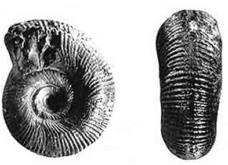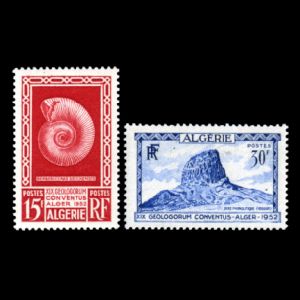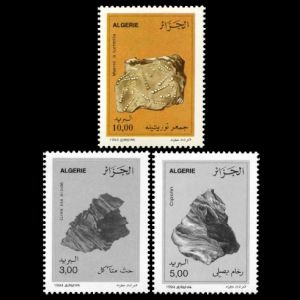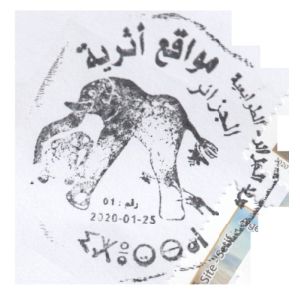the place where Paleontology and Paleoanthropology meets Philately
Algeria
Fossils on stamps of Algeria
| << previous country | back to index | next country >> |
Contents:
- Country overview
- Philately of Algeria
- Official stamps of Algeria related to Paleontology
- Commemorative postmarks of Algeria related to Paleontology
- References
- Acknowledgements
Algeria, officially People's Democratic Republic of Algeria, is a country in North Africa on the Mediterranean coast. Its capital and most populous city is Algiers. Algeria is the tenth-largest country in the world, and the largest in Africa and the Arab world. Algeria is bordered to the northeast by Tunisia, to the east by Libya, to the west by Morocco, to the southwest by Western Sahara, Mauritania, and Mali, to the southeast by Niger, and to the north by the Mediterranean Sea. The country is a semi-presidential republic consisting of 48 provinces and 1,541 communes. [R1]
Algerian mail used stamps of France beginning 1 January 1849. Early cancellations were a simple grill similar to French usage, but after 1852 the service switched to a lozenge of dots surrounding a number identifying the post office.

|
| The image is from parvaencyclopaediaphilatelica.it |
The first Paleontology related stamp of Algeria was issued in August 1952. The set of stamps was commemorated the XIX International Geological Congress which was held in Algeria in 1952. The paleontologically-themed stamp shows a fossil of an ammonite. The fossil is of Berbericeras sekikensis.
This ammonite stamp is the first ever stamp to show a depiction of a fossil.This stamp is the first stamp of fossil ever. The second stamp shows a Phonolite dike from Hoggar, Algeria. Phonolite is a volcanic rock made of fine-grained feldspar and nepheline.
Official stamps of Algeria related to Paleontology: fossils
| 11.08.1952 "XIX International Geological Congress" | 21.09.1994 "Minerals" [1] | 25.01.2020 "Archeologic sites" [2] |
 |
 |
 |
Notes:
[1] Fossils of marine snails of the genus Turritella on stamp of D10,00.
[2] Archeologists have discovered lithic tools and animal bones at the site of Ain Al Hanesh dating from 2.4 million years ago.
The French paleontologist, Camile Arambourg, was able to prove that the site was a plio-pleistocene deposit.
He identified and classified the bones at the site – recognizing the presence of a diverse assemblage of mammals including elephants, equids, cows, hippopotamus, rhinos, etc.
At the site, he also found cut pebbles that he interpreted as Oldowan sub-spheroidal and spheroidal polyhedrons. This was a significant discovery that found ancient Oldowan artifacts associated with the fossilized bones of savanna animals.
Commemorative Postmarks directly related to Paleontology and Paleoanthropology: prehistoric animals
Legend is here| 25.01.2020 Archeologic sites" [FDC] [PM1] | ||
 |
|
|
Notes:
[PM1] Replication of the elephant image from the cave painting, as depicting on one stamp of the set of Algeria 2020 "Archeologic sites"
References:
- [R1] Algeria: Wikipedia, WikiTravel, FlagCounter.
- [R2] Postal History and Philately of Algeria:
Wikipedia,
Links to official website of the Post Authority, stamp catalog and a list of new stamps of Algeria are here.
Acknowledgements:
Many thanks to Dr. Peter Voice from Department of Geological and Environmental Sciences, Western Michigan University, for reviewing the draft page and his very valuable comments.
| << previous country | back to index | next country >> |